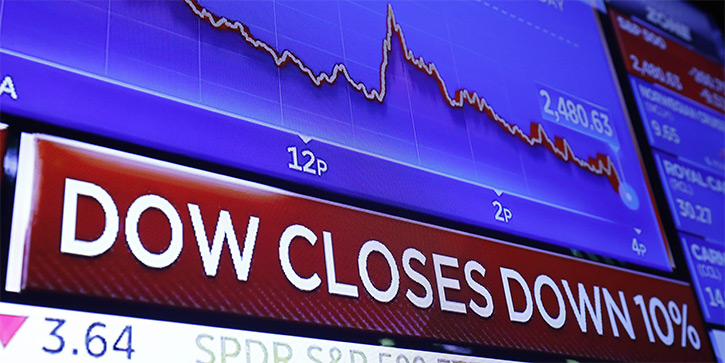
Volatility for Dummies
-
 Jared Dillian
Jared Dillian
- |
- March 19, 2020
- |
- Comments
I am a big fan of the “For Dummies” books.
I’m a pretty dang good DJ, and 12 years ago, I taught myself to DJ by reading DJing For Dummies. When I started my podcast, I got Podcasting For Dummies. Went through a juicing phase and got Juices and Smoothies For Dummies.
I have a bunch of other ones, too, including Personal Finance For Dummies, which is written by a guy who has “MBA” after his name.
That’s why I’ve been contracted to write the new Volatility For Dummies:

Just kidding, I am doing no such thing.
Equity volatility has turned into a big asset class. When I started trading 20 years ago, it was just puts and calls and dynamic hedging. Now we have VIX futures and options, variance swaps, exotic options, plus a bunch of other crazy stuff.
The equity vol community is large enough that it actually has its own subculture on Twitter. There are some pretty colorful characters.
As you have probably noticed, stocks are a wee bit more volatile these days. We’ve approached levels of volatility similar to what we experienced during the financial crisis, and before that, the Great Depression. It’s pretty intense.
I can tell you one thing: If you can handle this, you can handle anything. I would characterize any move over 2% in the stock market as large. 10% is, well, the largest since the crash of 1987.
In a plain vanilla sense, you are probably wondering how to mitigate the volatility in your portfolio, which is freaking out. You could step into your time machine, go back a few months, and buy some bonds. Except, even bonds are not helping now.
All kinds of wacky stuff is happening in the bond market, and bonds aren’t really providing any diversification benefits anymore, as risk parity strategies unwind.
Gold is supposed to provide some diversification benefits, but isn’t, because of liquidation. Commodities, no help. Real estate, no help.
The stark reality: In a crisis, correlation goes to 1 and everything moves in lockstep. And that is the problem with 95% of portfolios out there.
Correlation is the risk that nobody sees. Correlation is the risk that nobody saw in 2008, which was precisely the cause of CDOs and such blowing up. Correlation is always lurking. Correlation is the relationship between currencies and bonds and stocks and banks and people that you don’t see until it’s too late.
Correlation causes weird stuff to happen. I heard about a high-yield muni bond fund that sank 16% in a day. No way in a million universes should that happen. Correlation. Someone is losing money over there, so he has to sell a winner over here. That is happening times a thousand in the markets right now.
Like what you're reading?
Get this free newsletter in your inbox every Thursday! Read our privacy policy here.
To be honest, this stuff happened back in 2008, and it’s been so long I simply forgot what it was like. I had a portfolio that I thought was bulletproof that turned out to be okay, but not entirely bulletproof. You have no idea where the weaknesses are until it’s too late.
|
|||||||||||||
Fragility
I will borrow a little Nassim Taleb for a paragraph—it’s about the difference between building portfolios that are fragile versus those that are antifragile. As most people have found out in the past few weeks, they had fragile portfolios. Most people did.
You want to build a portfolio that gains from disorder. Not many people did that, outside of some vol funds and the tail risk guys, who do that sort of thing for a living.
You can’t be a tail risk fund, so don’t even think about it.
The reality is that we are all more or less long-only investors, and once every 12 years we are going to get clubbed over the head with a baton. You can take steps to mitigate this (like the 35/65 portfolio), but the tradeoff is lower returns. So, is there no hope?
Let me speak briefly about sentiment trading and asymmetry. One of the cool things about being a sentiment trader is that you are always betting against the crowd. If people are excessively bearish, you’re bullish, and vice versa.
The nice thing about this is that it frequently puts you in low-risk trades where there is significant asymmetry—you can make more than you can lose.
Of course, none of us know what the real probability distribution is, but if you have some experience and a nose for crowd psychology, you will be risking a little to make a lot, rather than risking a lot to make a little.
Whenever I trade, I think about this asymmetry (which some people might call optionality). It’s one of the reasons I’ve been short Canadian banks all these years—even in the best-case scenario for the Canadian banks, I never perceived a lot of upside. And that was the right call.
Value investors do this, too—they invest in things with a margin of safety. Sentiment trading is a distant cousin of value investing.
When you invest this way, you tend to be less exposed to large shocks. Oftentimes you will have built a portfolio that gains from disorder. And it always helps to have a hedge—buying a few deep out-of-the-money puts is never a bad idea, as long as you remember to sell them.
If you didn’t get it right this time, for the killer virus, make sure you get it right for next time, when the asteroid hits.

Jared Dillian
subscribers@mauldineconomics.com

 Jared Dillian
Jared Dillian
